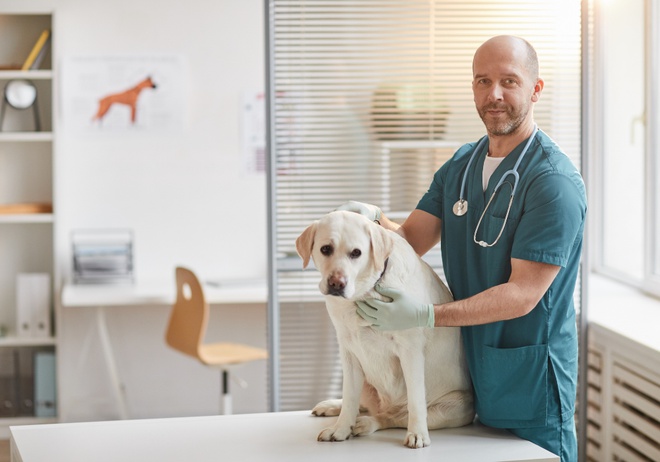How to microchip a dog or a cat?
Do you want to know more about microchipping before having your pet chipped? In this article you will find all the information you need to know about the steps to follow to have your pet identified.

Reading time : 4 min
Microchipping is a technology that allows you to locate your dog or cat if it is lost or stolen. Collars and tags can be helpful when you need to find a missing pet, but there is always a risk that they will fall off or become illegible over time. A microchip, on the other hand, is placed under the skin of your pet and is therefore a more reliable and permanent form of identification.
Without identification, the dog warden cannot let you know that your pet has been found. After seven days, your pet may be passed to a rehoming charity, or they may be euthanised by the local authority. It is therefore very important to have your pet microchipped. This article explains the different steps to follow in order to microchip your pet.
TOPICS
Why should you get your pet microchipped?

Protects against pet thefts
Purebred pets can be a source of envy for unscrupulous neighbours or people. A pedigree dog or cat is expensive. It could therefore be stolen by someone who wants to adopt a purebred pet at a lower cost in order to make some profit.
A chipped animal has an official owner. If the owner notices the theft, it is quite possible for him to prove that the cat or dog belongs to him and to report it to the authorities.
This is because the owner holds the dog or cat identification card which corresponds to the pet ID number, which itself contains the owner’s details.
In order to travel
In order to take your pet with you on a trip, it must be correctly identified. A microchip is required when travelling with your pet abroad and throughout the EU. The microchip number will also be recorded on your pet’s passport, another entry requirement for your dog or cat.
If you are travelling, your pet's microchip must be an ISO standard 15-digit microchip. You must bring your own microchip reader if your pet's microchip does not meet ISO standards.
In case of emergency
If you have to leave your home in a hurry due to an emergency or disaster, you may not always have time to ensure that your cat or dog is properly transported during the evacuation. If your pet is accidentally released during a crisis situation (fire, earthquake, hurricane, etc.), you will have a much better chance of finding your beloved pet if it is microchipped.
There have been a number of noteworthy incidents of microchipped cats being returned home, sometimes from far away, because their microchips were scanned by vet clinics or animal-shelters.
Who can microchip a dog or a cat?

The implant process is painless and does not cause discomfort if done properly. Implanting a pet microchip seems like a simple procedure but don't risk doing it yourself. Although it looks like a simple injection between the shoulder blades.
It is very important that this small microchip, the size of a grain of rice, is implanted correctly. Implanting the hypodermic needle with too much force, too deeply, or in the wrong place can not only make it difficult to detect or read the chip, but it can also damage your pet’s health, leading to life-threatening problems.
Microchips should always be injected by a qualified health veterinary professional, as he knows exactly where to place the microchip, how much pressure to apply and how to recognise the signs of a problem and treat it if it occurs.
When to microchip your pet?

During a routine visit to the vet
It is advisable to wait until the dog or cat is 8 weeks old before having it microchipped. The sensation of microchip implantation is similar to a routine vaccination. The procedure can therefore be carried out during a routine visit to the vet as no surgery or anaesthetic is required.
During a procedure that requires anaesthetic
However, to reduce discomfort, many pet owners choose to chip their pet under anaesthetic for another procedure, such as neutering or spaying. Many kittens are chipped under anaesthetic because they are more fragile.
Obviously, if the pet is already chipped when you adopt it, it will no longer be necessary to have it microchipped. All you have to do is contact the database where the pet is registered to update the information.
Just microchipping isn’t enough

Register your pet
When you have your pet microchipped, you must complete the paperwork that comes with the embedded microchip so that it can be registered. The contact details you fill in on these forms will allow your pet to be returned to you if it is ever lost or found. You must make sure you register your pet on a database that meets government standards.
If you are given or if you adopt a pet already microchipped, you must re-register the same microchip and identification number with your details on the same database. In this case, you can’t choose the database. If you don’t know which database your pet is registered with, enter the unique microchip number in a microchip lookup tool to it find out.
Keep your information up to date.
If you move, change your phone number or if any other registration information change, make sure you inform your vet or contact the database your pet is registered with. You can contact the database by calling the database phone number or by logging into their website. They will update your information as soon as possible so that your pet can return to the right place if it is lost.
Conclusion
Having your pet microchipped is a way of ensuring its safety by giving it an official existence and giving yourself every chance of finding and being reunited with your lost pet. Make sure you take your pet to the vet, as this is a veterinary procedure.
But pet identification alone is not enough, you must ensure that throughout the life of the animal you report any change of address or owner to the database in which you have registered your registration information so that the chip stays functional.
Continue reading our guide
This article is part of a complete guide on the subject. Do not miss the next chapters.
Are you an expert on pet microchipping?
Test your knowledge!
Answer our 7 questions on pet microchipping.
